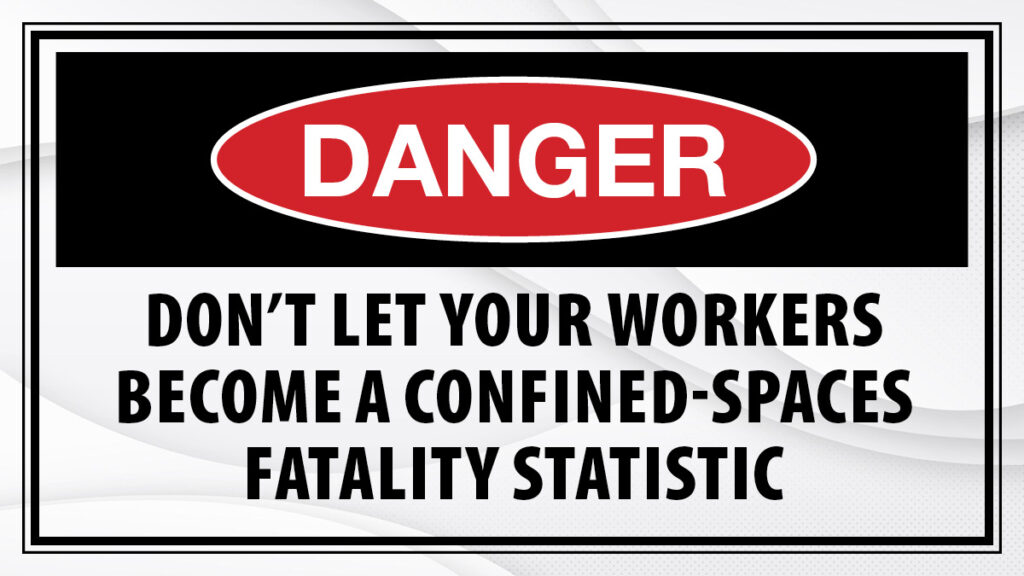On average in America, two workers die every week in accidents related to confined spaces. In recent years, the number of deaths in confined spaces ranged from 81 in 1998 to 136 in 2015, according to the U.S. Department of Labor’s Bureau of Labor Statistics (BLS). The five-year period covering 2005-2009 was particularly bad for confined spaces accidents, with 481 fatalities reported.
The BLS and the National Institute for Occupational Safety and Health (NIOSH) have other data to report:
- About 2.1 million workers enter permit confined spaces annually.
- Approximately 60 percent of confined-space fatalities are would-be rescuers.
- Asphyxiation (from oxygen deficiency or toxic air) is the leading cause of death in confined spaces, followed by physical hazards (collapses, falling debris, falls, etc.).
The Department of Labor’s Occupational Safety and Health Administration (OSHA) notes that many workplaces contain areas considered to be “confined spaces.” These are spaces that aren’t necessarily designed for people but are large enough for workers to enter and perform certain tasks. A confined space also has limited or restricted means for entry or exit and is not designed for continuous occupancy.
OSHA has identified many types of confined spaces in more than 20 major sectors of industry and labor. These spaces include tanks, vessels, silos, storage bins, hoppers, vaults, pits, manholes, tunnels, equipment housings, pipelines, and ductwork.
Additionally, OSHA uses the term “permit-required confined space” (permit space) to describe a confined space that has one or more of the following characteristics:
- Contains or has the potential to contain a hazardous atmosphere;
- Contains material that has the potential to engulf an entrant;
- Has walls that converge inward or floors that slope downward and taper into a smaller area that could trap or asphyxiate an entrant; or
- Contains any other recognized safety or health hazard, such as unguarded machinery, exposed live wires, or heat stress.
Construction workers often perform tasks in confined spaces. Physical and atmospheric hazards can be prevented if addressed prior to entering the space to perform work, OSHA states.
Confined-space emergencies demand highly qualified and specially equipped individuals to provide timely help and perform any necessary rescues. Expert and certified training in confined-space monitoring and rescues is available from the professionals at Safety Solutions & Supply.
Safety Solutions & Supply and Confined-Spaces Training
Safety Solutions & Supply is the premier local training provider in developing personnel for the hazards of confined-space work and for confined-spaces rescue. Two programs are offered: Confined Space — Entrant / Attendant and Supervisor Training, and Confined Space Rescue / High Angle Training.
Confined Space — Entrant / Attendant and Supervisor Training is an eight-hour program that includes hands-on learning, practical evaluation, and a written assessment. It’s designed to qualify and re-certify workers as confined-space entrants, attendants, and entry supervisors.
This program addresses the elements of the OSHA confined-spaces standard; atmospheric testing and control; horizontal and vertical entry methods; permit use and management; duties of entrants, attendants and supervisors; entry termination; and emergency management.
Our trainers can come to an employer’s site or provide training at our state-of-the-art training center in Mulberry in Central Florida.
Confined Space Rescue / High Angle Training is an eight-hour refresher class and a 24-hour new responder class that adheres to the standards outlined in OSHA 29 CFR 1910.146 and other applicable OSHA standards. This program includes selection of equipment, protection vs. prevention, and inspections.
This training places students in real-world situations and has them responding to multiple technical rescue operations. The students have the opportunity to develop the fundamentals skills they will use to respond to rescue situations in realistic environments under real-life conditions. At Safety Solutions & Supply, we think that this is the only way students can gain some of the essential experience they will need to handle any real-life confined-space rescue situation.
Construction work hazards create unique challenges to control. Jobsite construction hazards change with every minute work is occurring. Construction work hazards are unique and create unique challenges to control. Effective construction safety training is an essential part of creating and maintaining a safe worksite.
Safety Solutions & Supply programs are all custom developed and updated routinely to ensure that the highest quality message is provided to workers in training. All our instructors are experienced in the subjects they teach.
For answers to frequently asked questions about confined spaces work, rescues, and regulation, visit the OSHA confined spaces web page. For information about the safety services, training programs, and products offered by Safety Solutions & Supply, visit our website, or call toll free at 1-866-537-2262.

